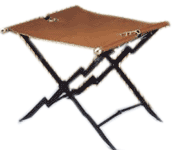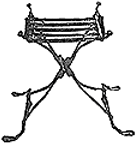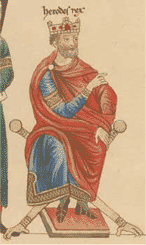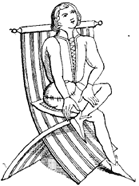Traveling within the World
Linking your favorite traveling artists across the globe
THE ILLUSTRATED HISTORY OF FOLDING CHAIRS © designboom
| ancient history folding chairs / medieval |
||
| ............................................................................................................ |
||
the folding stool as a ceremonial chair developed in two ways : one secular, and the other ecclesiastical. the makeup of the roman 'sella curulis' assumes, through the longobard 'sella plicatilis' in steel, the form of the carolingian 'faldistorium'. here we notice another typological alteration. the crossed legs are frontal instead of being placed laterally. this was to emphasize the crossing 'X' structure which became a re-inforced symbol of authority. the most emblematic example is the throne of dagobert I, king of the franconians (arm- and backrests were added later). the 'faldistorium' in time acquired arms and a back, while retaining its folding shape. the most famous, as well as the most ancient, english chair is that made at the end of the 13th century for edward I., in which most subsequent monarchs have been crowned. in spite of this, it was mostly used in ecclesiastical settings. we can assume that christianism, (the newly adopted official religion), was the factor that made this radical change, as 'sella curulis', such an official symbol, had to be altered to break with the past and the X, the cross symbol, to be shown in front view. the 'faldistorium' became also the archbishop's kneeling stool. this new function remained through the renaissance. (in oriental cultures, where the cross symbol had not such an importance, alteration from side- to front- X has never been made.) front- X became the norm untill in the renaissance the 'chair of petrarca' and the sissors chair / 'sedia a tenaglia' restored the crossed legs placed laterally. 'endowed ' bishops chairs of the mid 13th century, with crossed legs normally were not foldable, the 'X' structure had exclusively symbolic value. renaissance the (pre) renaissance folding stools had an interesting alteration of their front X by multiplicating the X-s on the Z axis. visually like an object in opposite mirrors or like a concertina barrier which expands on the Z axis. this was an extraordinary stylistic discovery, giving the stool - that descended from the faldistorium - the necessary depth, while making it extremely light, yet strong. the frontal X also gave the armrests. the typology of the folding 'chair' officially appeared with the renaissance. in the 16th century we find the the scissors chair / 'sedia a forbice'. there are two principal variations: the 'savonarola' and the 'dantesca', followed by the pincer chair / 'sedia a tenaglia'. this chair represents the return of the crossed legs placed laterally. both versions have been used since. the renaissance revived strongly the curved-legs shape, most probably of roman 'sella curulis' inspiration. it is to note that the 'savonarola' and the 'dantesca' had a more elaborated shape of the curved X - a kind of double curve - giving the illusion of the left/right side of the frontal X being made out of a single piece. another famous renaissance chair is the chair of the poet petrarca. the 'petrarca' chair with crossed legs was not foldable, because of its fixed joints, but it could be easily assembled. the 'X' structure had mostly symbolic value. the folding chair - its history as symbol of authority is also traceable in the following cultures. see asia |
 carolingan 'faldistorium'  'sella plicatilis' civic museum, pavia, italy  'hortus deliciarium', a medieval manuscript is showing herodes on his 'faldistorium' throne, a front X version chair in a biblical scene.  throne of dagobert I, king of the franconians  not foldable base of a medieval stool, X- structure has only a symbolic value.  endowed chair, not foldable  monk writing a manuscript, sitting on a 'scissors stool'  folding 'scissors' armchair  pope julius II and the folding kneeling stool (detail of a fresco by raphael: 'la messa di bolseno', the vatican museum, rome)  english folding chair 14th century  'savonarola' chairs, 16th century, tuscany, italy  'dantesca' chairs, 16th century, tuscany, italy  pincer chair / 'sedia a tenaglia', ca. 1530 casa bagatti valsecchi, milano, italy  pincer chairs / 'sedie a tenaglia', 1530 palazzo davanzati, florence, italy  'sedia a tenaglia', 'modern version' ca. 1560, villa maser (andrea palladio), italy  folding chair, ca. 1550, museum citta di castello, italy  'petrarca' or 'glastonbury' chair, not foldable  variation of the 'faldistorium' stool, 1580 |
|
THE ILLUSTRATED HISTORY OF FOLDING CHAIRS
© designboom
(compiled by birgit lohmann - a thesis publication, july 1988, revised in june 2003)
this history timeline is provided for educational purposes only,
no reproduction, re-use or transcription for any commercial purpose or use of the content or images is permitted. http://www.designboom.com/eng/education/folding/medieval.html
a print-publication will soon be available, for inquieries : mail@designboom.com
Tags:
Replies to This Discussion
-
Permalink Reply by Dept of PMM Artists & things on February 8, 2011 at 4:56pm
-
THE ILLUSTRATED HISTORY OF FOLDING CHAIRS
has been compiled by birgit lohmann
(a thesis publication, july 1988, revised in june 2003)
© designboom
this history timeline is provided for educational purposes only,
no reproduction, re-use or transcription for any commercial purpose
or use of the content or images is permitted.
a print-publication will soon be available,
for inquieries : mail@designboom.com
---
acknowledgement
many thanks to the participants of designboom's second
design-aerobics course - a special thanks goes to the following
people for their contributions:
art perper, takashi ifuji, radu comsa, joshua larrabee, jim nagel,
erin caruth, larry cheng, carolina jimenez, michelle brick,
kevin mc donald, stanley ruiz, joellen schilke, marcos breder,
phil clowes, beatriz crespo, peter pontano,
susana salomon, oscar riano and haral jarabek. -
Events
-
2014 is the Chinese Year of the Horse
February 17, 2026 at 12am to February 5, 2027 at 12am – where & how you choose
Birthdays
Birthdays Today
Birthdays Tomorrow
Important (read & understand)
Skype: Travelingraggyman
Email and Instant Messenger:
TravelerinBDFSM @ aol/aim; hotmail; identi.ca; live & yahoo
OR
Travelingraggyman @ gmail and icq ***

1AWARD UPDATES & INFORMATION
10,000 votes - Platinum Award
5,000 votes - Gold Award
2,500 votes - Silver Award
1,000 votes - Bronze Award
300 votes - Pewter Award
100 votes - Copper Award
Member of the Associated Posting System {APS}
This allows members on various sites to share information between sites and by providing a by line with the original source it credits the author with the creation.
Legal Disclaimer
***************We here at Traveling within the World are not responsible for anything posted by individual members. While the actions of one member do not reflect the intentions of the entire social network or the Network Creator, we do ask that you use good judgment when posting. If something is considered to be inappropriate it will be removed
Site Meter
This site is strictly an artist operational fan publication, no copyright infringement intended
Patchwork Merchant Mercenaries had its humble beginnings as an idea of a few artisans and craftsmen who enjoy performing with live steel fighting. As well as a patchwork quilt tent canvas. Most had prior military experience hence the name.
Patchwork Merchant Mercenaries.
Vendertainers that brought many things to a show and are know for helping out where ever they can.
As well as being a place where the older hand made items could be found made by them and enjoyed by all.
We expanded over the years to become well known at what we do. Now we represent over 100 artisans and craftsman that are well known in their venues and some just starting out. Some of their works have been premiered in TV, stage and movies on a regular basis.
Specializing in Medieval, Goth , Stage Film, BDFSM and Practitioner.
Patchwork Merchant Mercenaries a Dept of, Ask For IT was started by artists and former military veterans, and sword fighters, representing over 100 artisans, one who made his living traveling from fair to festival vending medieval wares. The majority of his customers are re-enactors, SCAdians and the like, looking to build their kit with period clothing, feast gear, adornments, etc.
Likewise, it is typical for these history-lovers to peruse the tent (aka mobile store front) and, upon finding something that pleases the eye, ask "Is this period?"
A deceitful query!! This is not a yes or no question. One must have a damn good understanding of European history (at least) from the fall of Rome to the mid-1600's to properly answer. Taking into account, also, the culture in which the querent is dressed is vitally important. You see, though it may be well within medieval period, it would be strange to see a Viking wearing a Caftan...or is it?
After a festival's time of answering weighty questions such as these, I'd sleep like a log! Only a mad man could possibly remember the place and time for each piece of kitchen ware, weaponry, cloth, and chain within a span of 1,000 years!! Surely there must be an easier way, a place where he could post all this knowledge...
Traveling Within The World is meant to be such a place. A place for all of these artists to keep in touch and directly interact with their fellow geeks and re-enactment hobbyists, their clientele.
© 2025 Created by Rev. Allen M. Drago ~ Traveler.
Powered by
![]()